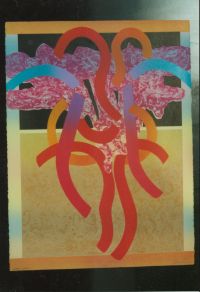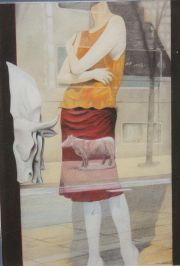Herman Schmeling Encounters Lyle MatoushSeven years ago come June, Sylvia and I drove to Wisconsin to visit friends and relatives. We took our Ford pickup, for the purpose of hauling some old furniture back, and we slept in the truck bed, under the canopy, on a makeshift mattress. In late afternoon of the fourth day we pulled into a KOA campground in Moorehead, Minnesota, just across the Red River from Fargo, secured a camp site and found a place nearby to eat. That night, I went to the

Rumba Ribbon (Click on image for more.)
|
|
|
bathroom, intending to clean up for the next (and last) day of our trip. As I stepped up to the sink to shave, I heard someone say, “Hi, Herman.” There, a few sinks away, examining his grizzled face in the mirror, was Lyle Matoush. After we greeted each other, Lyle asked me to bring Sylvia over to visit with him and Jime. We had a nice chat with Lyle and Jime that June night, sitting at a picnic table next to their 1991 VW camper microbus. They were headed, Lyle said, to Ferris State University in Big Rapids, Michigan, where Lyle ’s prints were to be exhibited in his one person show. (He had shipped the prints to Big Rapids before leaving Ashland.) This was my first inkling that Lyle hadn ’t really retired. That show in 1998, Lyle informed me re cently, was his last print show; he had stopped making prints in 1996, he said, because the process was “too stressful on my body.” The lithographic process. Lyle ’s class handout informs me “is essentially chemical in nature,depending on the inter action of oil and water.The image is print ed from what the artist draws or paints on the surface of a zinc or stone plate with a grease pencil.... The plate/stone is damp ened with water, which covers the surface except for the greasy design. The printing ink is applied over the plate/stone. Paper placed on this surface picks up only the image which is inked. Each color must be put on the stone or plate and printed separately.” The stone plate can be quite heavy; hardest on the back, though, are the heavy rollers. Rolling the forty pounders back and forth for many years damaged Lyle ’s back; the damage required two cor rective surgeries. For over 25 fruitful years Lyle made prints and taught printmaking. On his first sabbbatical in 1972 (he had come to SOU in 1965), he had gone to San Francisco to work in a professional print shop. In order to become a master lithog rapher he studied privately with Master Lithographer Ernesto de Sota. At that time there were fewer than 50 master printers in the country. In 1979 he went to the University of California at Fullerton to learn photo processing for printmak ing and electro-forming techniques for making jewelry. In a small way Lyle ’s ac quired knowledge about jewelry making paid off for us,since our son Max took Lyle ’s jewelry making class over 20 years ago and made his mother a lost wax metal rose pin which she still wears (Wax is lost when the mold melts.)So did his knowledge of printmaking benefit us, as
we own and display an interesting print called “Vanishing Totems.” Shortly before Lyle fully retired from SOU, Presi dent Joe Cox talked him into going to Guanajuato University for a few months to teach printmaking. Guanajuato ’s president Juan Carlos, the state of Guanajuato ’s new governor (who took his graduate degrees at SOU), introduced him to a young man named Miguel,who became Lyle ’s interpreter and good friend. When Lyle left Guanajuato he invited Miguel to attend SOU. Lyle interceded with Juan Carlos to help Miguel get a scholarship. Lyle and Jime asked Miguel to stay with them, and he did, for three years, until he finished his degree. He was like a son to them, says Lyle. Lyle gave him all his printing equipment when he returned to Guanajuato; it rests in Miguel ’s print shop in his and his wife ’s home. At the same time, the SOU art department gave the Guanojuato art department all their looms and the first lithographic press that Lyle had bought for the SOU department. Miguel now teaches printmaking at Guanajuato University and is director of computer curriculum there. In 1997, at the Degas show in Chicago Lyle saw a film on making pastels. That film led him to try pastels, which he had never done before. At first the new medium was slow going, resulting in no more that 10 to 12 creations a year. But now, a new creation emerges every eight to 10 days; he did about 40 in 2004. Since he started doing pastels in 1997, he has completed 144 of them. He works five to six hours a day. His current series, “Highland Pines,” is named after and in .uenced by the townhouse in High Pines, his and Jime ’s home in Talent for the past two years.Two attractive creations from this series are currently on display at the Schneider Museum faculty art show. Lyle ’s prints were mostly non-objective; his pastels are both objective and non-objective. He reminded me that objective refers to impressions of objects in nature or elsewhere,and non-objective art is spun out of the imagination. Lyle is often inspired by what appears to be the ordinary. For example, he took a photo of three mannequins in a Carmel shop window. That photo led to at least 40 pastels, a numbered mannequin series called "Window Dressing.” What distinguishes Lyle ’s pastels is the way he goes about blending colors with his hands. Therefore, they look like paintings. Lyle has exhibited his prints and pastels over fifty times from 1960 to the present. The exhibits and one and two person shows are dotted with awards. Forty of Lyle ‘s pastels .ll .ve rooms at the Museo Del Pueblo De Guanajuato. At least eight of these exhibitions have taken place since his retirement. He is justifiably proud of his role as one of the founders of the Northwest Print Council which includes members from the states of Alaska, Hawaii , Idaho, Montana, Oregon, Washington, and the Canadian provinces of Alberta and British Columbia. As a member of the Board of Directors for the past nine years, he is still active in this group. Lyle and Jime put 144,000 miles on their ‘91 camper microbus before getting rid of it. Many of those miles were spent taking off for exhibitions here and there. They no longer rough it when they travel. Neither do we. Lyle had a stroke recently. He is recovering nicely and has lost none of his unfailing cheerfulness..



